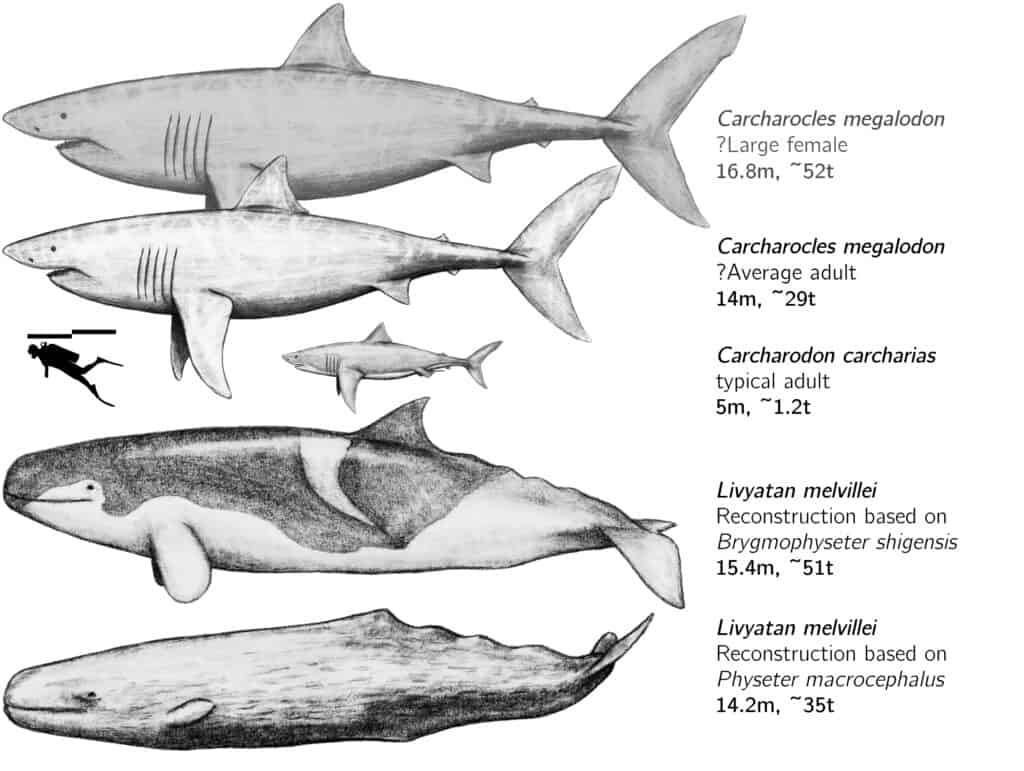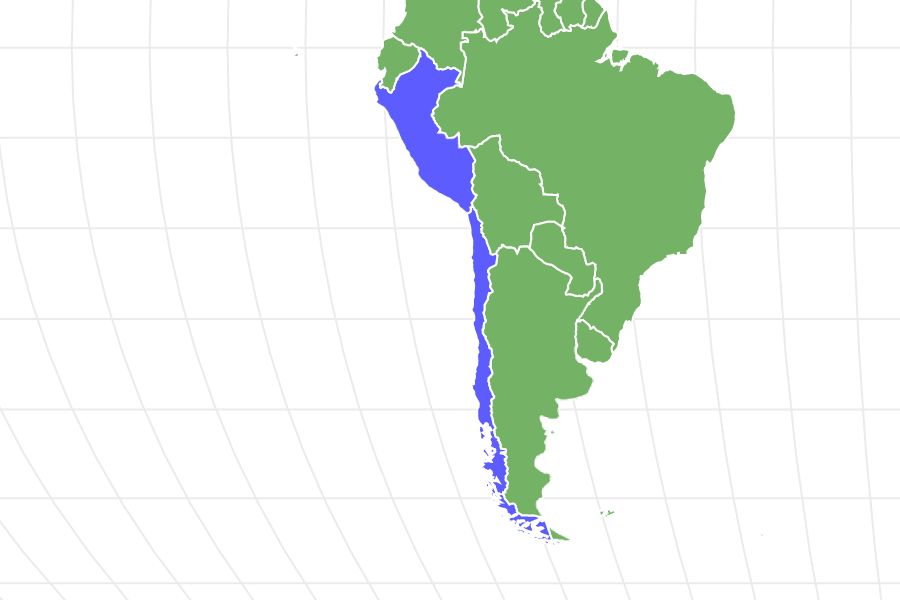The Livyatan had 1 to 1.2 foot long, interlocking teeth
Advertisement
Livyatan Scientific Classification
- Kingdom
- Animalia
- Phylum
- Chordata
- Class
- Mammalia
- Order
- Artiodactyla
- Family
- incertae sedis
- Genus
- †Livyatan
- Scientific Name
- †Livyatan melvillei
Read our Complete Guide to Classification of Animals.
Livyatan Conservation Status
Livyatan Facts
- Fun Fact
- The Livyatan had 1 to 1.2 foot long, interlocking teeth
- Most Distinctive Feature
- A large basin in the skull for echolocation and fighting
- Diet
- Carnivore
View all of the Livyatan images!
Livyatan melvillei, commonly known as Livyatan, was an ancient whale that owned the oceans millions of years ago. The only thing we can tell that shared the water with them and was a comparable size and threat was the megalodon shark. Other than that, Livyatan was the apex predator of the Miocene epoch.
Everything we know about this incredible sea creature (or monster, depending on who you ask) comes from carefully observing the limited fossil records we have. There has only been one partially preserved skull and jaw discovered. And along with several teeth, this is all we have to tell us about Livyatan. However, with the incredible technology we have and the comparisons we can draw from their modern relative—the sperm whale—there is a lot we can tell about this creature’s life.
Description & Size
You may have heard of the Biblical sea monster—the Leviathan, and you’re probably familiar with the fearsome sperm whale from Moby Dick. Livyatan’s name is inspired by each of those relatively modern names compared to how long ago this great sea creature lived.
The Livyatan is the only species from the extinct genus: macroraptorial sperm whale. Concerning size, our current data suggest it was approximately the same size as the modern sperm whale. Records indicate that Livyatan’s total length was likely around 13.5 to 17.5 meters (44 to 57 feet) and weighed around 62 tons (57 tonnes) based on its length. In addition to the modern sperm whale, Livyatan was also comparable in size to the ancient megalodon shark.
The primary reason we can only estimate the size of the whale is that we’ve only discovered a skull and some teeth. However, using the length of the skull (3 meters or 9.8 feet long), scientists can estimate the size based on Livyatyn’s modern relative.
However, its body size wasn’t the only fearsome aspect of this sea creature. It also boasts the largest biting teeth (excluding tusks) of any discovered animal. At over one foot long, the gaping mouth of the Livyatan would have been a terrifying sight. The fossil evidence suggests that Livyatan would bite off large chunks of its prey with these massive teeth. Also, the strange wear on opposing teeth suggests that they are interlocked to keep struggling prey from escaping the creature’s mouth.
The modern sperm whale and Livyatan share one thing in common, though. The basin at the top of their skull that housed the spermaceti organ is a similar size. However, the Livyatan’s basin did not hang over the eyes; it was defined by high bone walls. As long as this served the same function as modern sperm whales, this basin and organ would have been used for echolocation and ramming other creatures.

©By Darius Nau – Own work, CC BY-SA 4.0, https://commons.wikimedia.org/w/index.php?curid=69681270 – License
Diet – What Did Livyatan Eat?
As best as we can tell—given the time period it lived in, and how big it was—Livyatan would have been an apex predator in the seas. Unlike the modern sperm whale, who spends most of its time in deep water feeding on small to medium prey, Livyatan probably hunted large prey like baleen whales, sharks, or other marine vertebrates near the surface. In fact, its hunting patterns probably had more in common with the modern killer whale; it would chase other creatures until they were tired, then drag them down until they drowned.
It’s hard to say whether Livyatan hunted in packs like the killer whale, though. It was likely big enough to be a “lone wolf” hunter. However, it probably shared similar food sources and hunting grounds with another top predator in the water; the megalodon shark. So, it’s possible they shared similar habits to their modern sperm whale ancestors and occasionally hunted in packs, which would discourage a megalodon from bothering them.
Habitat – When and Where It lived
The only conclusively identified fossils from Livyatan have been found in Peru and Chile. But several other places like Australia, South Africa, and Argentina were home to some large sperm whale teeth. Based on fossil dating records, these could have been a different species or possibly a close relative of this massive creature. These fossils tell us that Livyatan populations were likely spread across a large area. However, they probably restricted themselves to the Southern Hemisphere because of temperature and water pressure.
The evidence tells us that Livyatan lived long before we ever did because fossil dating puts their existence in the Miocene epoch; approximately 9.9 to 8.9 million years ago in the Upper Miocene during the Neogene period
Threats And Predators
Because of its large size, the Livyatan did not likely have many natural predators; in fact, it probably preyed on other predators in the ocean. However, because it shared the waters with the megalodon shark, there likely would have been some epic battles between them if they had decided not to leave each other alone.
The only real threat these whales would have experienced was finding enough food to survive. When they were alive, this wouldn’t have been a very big problem because their only major competition was the megalodon. But later on in their existence, as we find out when we talk about Livyatan’s extinction, competition for food grew fierce.
Discoveries and Fossils – Where It was Found
The first fossil of this sea creature was initially discovered in November 2008. It was a partially preserved skull that included some teeth and the lower jaw. The skull was found in the Pisco Formation sediments in Peru. The neat thing about the find is that it almost didn’t happen. It was the final day of a field trip when the researcher Klaas Post stumbled upon the fossil.
Since the original discovery, several other teeth have been found throughout the Southern Hemisphere. Some have been identified as belonging to Livyatan. But many of them aren’t officially classified as such. One of the main reasons for this is they are dated much younger (by several million years) than Livyatan. So, researchers assume they are a close relative to the ancient whale or possibly a similar species.
Extinction – When Did It Die Out?
One major contributing factor to Livyatan dying out was the water-cooling during the early Pliocene epoch, which began around 5.3 million years ago. Another factor that played into their extinction was the increase in killer whale populations. Livyatan didn’t suddenly become prey. However, the competition for food became too much for this 62-ton sea monster, and it couldn’t keep up with the changing times.
Similar Animals to the Livyatan
Similar sea creatures to the Livyatan are limited, but they include:
- Megalodon Shark: A similar-sized animal with an extremely powerful bite. This massive shark was a stealthy hunter and shared a similar food source to the Livyatan, so they would have met each other quite often. Because each of them was so large, they likely left each other alone for the most part.
- Mosasaurus: An aquatic dinosaur that lived around 82 to 66 million years ago. The largest estimates based on skulls put the Mosasaurus around 56 feet long. However, some fossils suggest there may have been larger ones out there. If this epic dinosaur had lived at the same time as Livyatan, there would probably have been some insane and destructive battles in the depths.
- Blue Whale: There aren’t many blue whales left because of overhunting. However, they currently hold the record for the largest animal to ever exist. The Antarctica blue whale has been known to reach nearly 100 feet! That being said, we have discovered fossils indicating that larger creatures may have existed.
Livyatan FAQs (Frequently Asked Questions)
How do you pronounce Livyatan?
It’s pronounced like Levi-ah-tan.
When was Livyatan alive?
Livyatan lived during the Upper Miocene epoch around 9.9 to 8.9 million years ago. They finally went extinct during the early Pliocene epoch, approximately 5.3 million years ago.
How big was Livyatan?
We’ve never discovered a complete skeleton, so all sizing is based on the skull and with reference to the modern sperm whale. Researchers’ current estimate is that Livyatan was around 44 to 57 feet long and weighed approximately 62 tons.
Between a megalodon and Livyatan, who would win a fight?
These two sea creatures were similarly-sized. The megalodon likely had a much more powerful bite and was a competent, stealthy killer. However, the Livyatan was used to prolonged battles and had much larger teeth, so it would probably win if the two met in a dark corner of the ocean.
Thank you for reading! Have some feedback for us? Contact the AZ Animals editorial team.

















